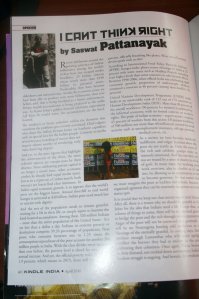
Photo theft is one of the banes of the internet.
It is not o.k. to sneak into a store or home, pick up something that catches your fancy and slink away without asking or paying for it. Then why do people do that with other people’s work – their photos?
Like this travel writers site Road Junky had an unauthorized photo of mine on their front page. Not only did they not ask my permission, they did not even bother to give copyright acknowledgment. And I found out only because someone recognized it as mine and reported it to me. They wrote back asking – which one? How many stolen photos do these people have on their site? They finally removed my photo without so much an apology.
Usually that’s how we find out our work has been stolen. But last month, for the first time I experienced the direct shock of opening a magazine and seeing my unauthorized photo stare back at me. Someone had handed me the magazine, Kindle, a glossy new magazine that all the Barista cafes in Calcutta stock, and said, “It’s very progressive and targets a younger readership. You should write something in here about your 50 Million Missing Campaign.”
Well I did write ! An angry email to the editor demanding an explanation. The magazine has a disclaimer, which says any photo not credited is courtesy of Reuters. Reuters! Really? The editor hurriedly disclaimed that too. No – it was the sloppy work of some untrained intern who probably thought that stealing was one of the magazine’s policies.
O.K. – I was willing to buy that and give them a chance to make amends. So I emailed that if they reprinted the photo with proper credit, paid me for it and sent a complimentary copy, I would accept that as an apology.
There was no response.
Well – things can happen that held up the response.
